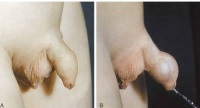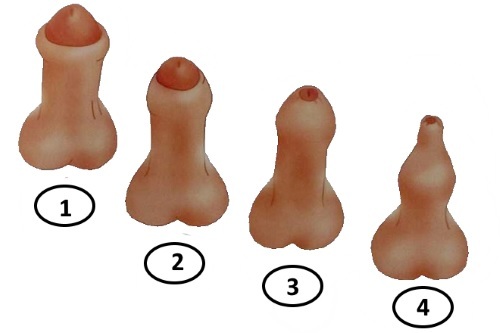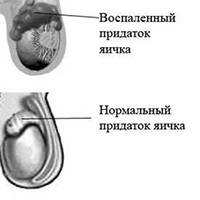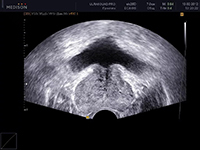Physiological phimosis in boys: when the head opens?
Phimosis is defined in medical practice as a state of physiological or pathological property, in which the glans penis can not be exposed due to the lack of elasticity of the prepuce. Normal like this is considered only up to a certain age. The number of boys suffering from physiological phimosis, according to statistics, is within 100%.In this case, spontaneous "cures" occur only in 75% of cases. The remaining clinical situations are associated with the transition of phimosis to a pathological form. But why does this happen and when to alarm parents?
Contents of
- 1 Brief Anatomical Reference
- 2 To what age is phimosis normal?
- 3 Symptoms of physiologic phimosis
- 4 Causes of phimosis transition to pathological form
- 5 Probable complications of physiological and pathological phimosis
- 6 Phases of pathological phimosis
- 7 Does physiological phimosis require surgical treatment?
Brief Anatomical Reference
The foreskin is an elastic skin fold located in the region of the glans penis. Performs, mainly, protective function, not allowing mechanically to injure the anatomical structures of the penis. Up to a certain age( the figures vary from source to source), this skin fold is fused to the glans penis with so-called synechiae. In addition, the foreskin is not sufficiently mobile. Together, these two factors make head exposure impossible. This is normal, since the boy's body has not yet formed. In a similar way, nature protects a young man from the stronger sex from infections that can penetrate the urethral canal from the outside.

In a newborn boy, phimosis is the norm
To what age is phimosis normal?
This is a controversial issue in medical science and practice. There are several periods of possible self-elimination of the problem of physiological phimosis:
- The first period covers the age of up to 6 years. According to the data of the same statistics, the question is resolved independently on the majority of patients. But there is a possibility of a longer preservation of the state of immobility of the foreskin.
- The second period concerns the age interval from 6 to 13 years. During this period the foreskin becomes mobile even in a third of the urologist patients.
- The third period lasts from 13 to 17 years. At this age in most young people the foreskin is shifted independently. We are talking about patients with late sexual development.
Symptoms of physiologic phimosis
The natural form of phimosis is characterized by the inability to bare the head of the penis.

Phimosis may cause urination disruption
In addition, if the condition is prolonged, it is likely that the following symptoms develop:
- Pain sensations in the region of the glans penis due to inflammation of the foreskin and other anatomical structures.
- Discomfort sensations in the groin area.
- Violations of urination: urine comes out dropwise or in a thin trickle. It occurs similar in severe physiological phimosis or neglected pathological.
Otherwise, there are no manifestations.
The causes of the transition of phimosis to the pathological form
The time of transition of the normal state to the pathological state, as a rule, falls on 6-7 years of life. The main causes of the development of pathological phimosis are the following:
- Insufficient amount of connective tissue. This is an inherent problem. Phimosis in this case is primary and predisposition to it develops even in the intrauterine period.
- Frequent inflammatory processes in the foreskin area. Each subsequent inflammation( balanitis and balanoposthitis are frequent guests in children, it is normal to exercise hygiene is prevented by the same phimosis) causes the formation of microcracks in the foreskin area. The tissues are scarred and become less elastic, which becomes a factor in the development of phimosis.
- Injuries to the foreskin area. As the body grows older, the boys begin an erection. If the foreskin is not sufficiently mobile and elastic, the likelihood of its tears is high. Than it is fraught - it has already been said.
Probable complications of physiological and pathological phimosis
The physiological form gives fewer complications, and they happen less often. First of all, we are talking about the following conditions:
- balanitis - inflammation of the foreskin;
- balanoposthite - inflammation of the foreskin and glans penis.
Both conditions develop due to the lack of intimate hygiene. It is important to bear in mind. In no case should you try to expose the head in your own strength. Some especially zealous parents try to artificially overcome phimosis. Nothing good will end there. The probability of becoming paraphimosis is great - the head is infringed by the ring of tight foreskin. This condition is similar to wearing a neck-tight necktie. The result is often necrosis of the head, and even the entire penis.

Sometimes a tight, foreskin ring leads to parafymosis
Phases of pathological phimosis
- stage 1.The head of the penis is bare in a calm state completely and without much effort. At the time of erection, difficulties with its removal from the prepuce and slight pain sensations are possible.
- 2nd stage. Characterized by difficulties in removing the head of the penis in a calm state. With great difficulty, the head is bare when the penis is in the erect state.
- 3rd stage. It is typical for her to bare the head during the erection period. In a calm state, it is excreted with great difficulty.
- 4th stage. The most neglected case. The head is not bare at all. There are problems with urination: urine is collected in the foreskin area and dropped out of the body by drops or a thin trickle. A characteristic sign of the fourth stage phimosis is the part of the hypertrophic foreskin hanging from the tip of the penis in the form of a proboscis.

Stages of pathological phimosis: on the first - the head is bare completely, on the fourth - the proboscis of the foreskin is formed
Does physiological phimosis require surgical treatment?
No sane doctor will circumcise a patient younger than 6-7 years old, unless it is a question of religious motives. This is the most active period of the formation of the boy's organism, not counting the puberty period. Dynamic monitoring of the child's condition is shown. In the future, if the head does not open for the boy 7 years and older, it is possible to perform the operation, but only according to the indications.

When phimosis is started, you have to make a decision about the surgical intervention of
. Indications are several:
- Frequent infectious lesions of the head and foreskin. Acute urinary retention.
- Phimosis in extreme stages( 3-4), which is clearly pathological in nature.
- Occurrence of parfymosis( operation is carried out on the same day)
Circumcision is an extreme measure. It all depends on the presence / absence of frequent inflammation and other complications, up to an acute urinary retention. If frequent balanitis and balanoposthitis are absent, there are no reasons for the operation as such, there is a possibility to wait with surgery( everything is decided at the discretion of the parents, taking into account the opinion of the doctor).In this case, a hormonal ointment( hydrocortisone) is prescribed to increase the elasticity of the foreskin.
Physiological phimosis is normal. It provides invaluable assistance in the formation of the boy's organism. But cases where the natural state is transformed into a pathological state are not uncommon. Then you can not do without treatment. To not miss the moment, it is important to regularly show your child to a urologist.
Recommended for viewing:



